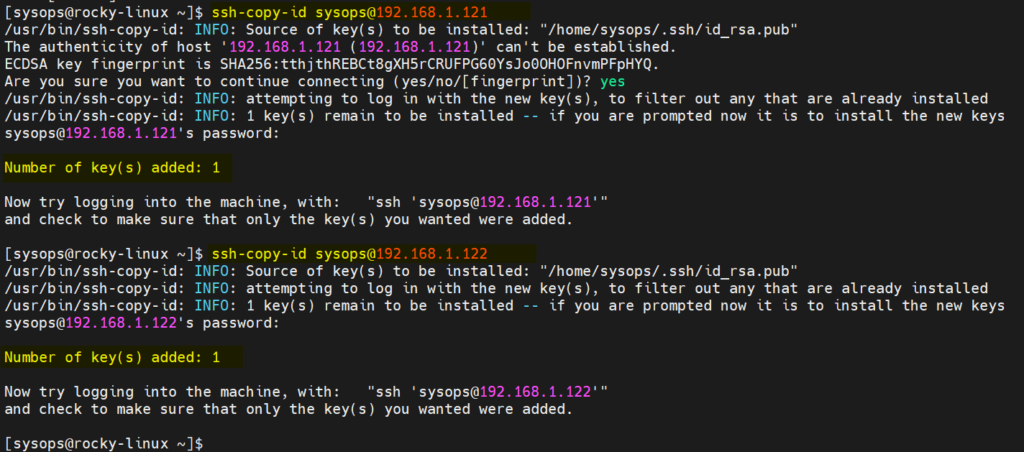

- Ssh copy id to remote how to#
- Ssh copy id to remote windows 10#
- Ssh copy id to remote password#
- Ssh copy id to remote windows#
# Make sure you're running as an Administrator. To start the ssh-agent service each time your computer is rebooted, and use ssh-add to store the private key run the following commands from an elevated PowerShell prompt on your server: # By default the ssh-agent service is disabled.
Ssh copy id to remote windows#
Use ssh-agent to securely store the private keys within a Windows security context, associated with your Windows account.

Ssh copy id to remote password#
Remember that private key files are the equivalent of a password should be protected the same way you protect your password. pub files are public keys, and files without an extension are private keys: Mode LastWriteTime Length Name Now you have a public/private ed25519 key pair in the location specified. SHA256:OIzc1yE7joL2Bzy8!gS0j8eGK7bYaH1FmF3sDuMeSj8 key's randomart image is: Your public key has been saved in C:\Users\username/.ssh/id_ed25519.pub. Your identification has been saved in C:\Users\username/.ssh/id_ed25519. Enter passphrase (empty for no passphrase): For this example, we're leaving the passphrase empty. The passphrase works with the key file to provide two-factor authentication. The passphrase can be empty but it's not recommended. You can press Enter to accept the default, or specify a path and/or filename where you would like your keys to be generated.Īt this point, you'll be prompted to use a passphrase to encrypt your private key files. The output from the command should display the following output (where "username" is replaced by your username): Generating public/private ed25519 key pair.Įnter file in which to save the key (C:\Users\username/.ssh/id_ed25519): To generate key files using the Ed25519 algorithm, run the following command from a PowerShell or cmd prompt on your client: ssh-keygen -t ed25519 A strong algorithm and key length should be used, such as Ed25519 in this example. If no algorithm is specified, RSA is used. ssh-keygen.exe is used to generate key files and the algorithms DSA, RSA, ECDSA, or Ed25519 can be specified. To use key-based authentication, you first need to generate public/private key pairs for your client. Since there's no user associated with the sshd service, the host keys are stored under C:\ProgramData\ssh. Get-Service -Name sshd | Set-Service -StartupType Automatic To start it each time the server is rebooted, run the following commands from an elevated PowerShell prompt on your server: # Set the sshd service to be started automatically Please see Getting started with OpenSSH.īy default the sshd service is set to start manually. You need to have OpenSSH Server installed first. The passphrase is used along with the presence of the private key on the SSH client to authenticate the user. The user will be prompted for the passphrase during authentication. Multi-factor authentication may be implemented with key pairs by entering a passphrase when the key pair is generated (see user key generation below). If the server-side public key can't be validated against the client-side private key, authentication fails. Key based authentication enables the SSH server and client to compare the public key for a user name provided against the private key. The public key is what is placed on the SSH server, and may be shared without compromising the private key. If someone acquires your private key, they can sign in as you to any SSH server you have access to. The private key files are the equivalent of a password, and should stay protected under all circumstances. SSH public key authentication uses asymmetric cryptographic algorithms to generate two key files – one "private" and the other "public". Key pairs refer to the public and private key files that are used by certain authentication protocols. If you're unfamiliar with SSH key management, we strongly recommend you review NIST document IR 7966 titled "Security of Interactive and Automated Access Management Using Secure Shell (SSH)".
Ssh copy id to remote how to#
This document provides an overview of how to use these tools on Windows to begin using key-based authentication with SSH. scp and sftp to securely copy public key files during initial use of a server.ssh-agent and ssh-add for securely storing private keys.OpenSSH includes tools to help support key based authentication, specifically: When working across domains, such as between on-premises and cloud-hosted systems, it becomes vulnerable to brute force intrusions.īy comparison, Linux environments commonly use public-key/private-key pairs to drive authentication that doesn't require the use of guessable passwords. Most authentication in Windows environments is done with a username-password pair, which works well for systems that share a common domain.

Ssh copy id to remote windows 10#
Applies to Windows Server 2022, Windows Server 2019, Windows 10 (build 1809 and later)


 0 kommentar(er)
0 kommentar(er)
